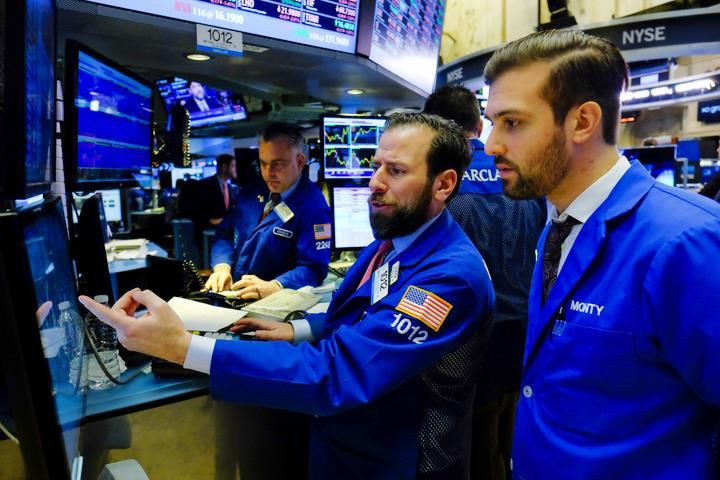Dow Jones Industrial Average Wavers After Touching Highest Level For The Year Following US Fed Announcement

This story was updated at 4:30 p.m. EDT.
U.S. stocks recovered Thursday from one of the worst starts to a year on record. The Standard & Poor’s 500 and Dow Jones Industrial Average ended the day above their 2016 opening-bell levels after a roller-coaster ride of volatility that had knocked 10 percent off both major indexes by mid-February.
The rally began a day earlier, spurred by the U.S. Federal Reserve’s surprise lowered projection for interest rate hikes in 2016. Low borrowing costs are good for corporate earnings, which boosts stocks. But fewer rate increases for the year indicate the central bank is still concerned the U.S. economy cannot absorb a faster pace of hikes without causing a slowdown in hiring and a risk of deflation.
“I think right now we’re in a period where the market is going to drift higher,” David Seaburg, head of trading at Cowen and Co., told CNBC’s “Trading Nation.”
After starting the trading session lower, the Dow (INDEXDJX:.DJI) ended the day up 155.73 points, or 0.9 percent, to 17,481.49. The Dow started the year at 17,405.48.
The broader Standard & Poor’s 500 index (INDEXSP:.INX) rose 13.37 points, or 0.66 percent, to 2,040.59. The S&P started the year at 2,038.20.
The Nasdaq composite (INDEXNASDAQ:.IXIC) gained 11.01 points, or 0.23 percent, to 4,774.98, its highest level since Jan. 6.
Nine out of the 10 S&P 500 sectors were up. Only healthcare stocks were down. General Electric Co. (NYSE:GE) led Dow gains while Merck & Co. Inc. (NYSE:MRK) led declines.
On the U.S. economic data front, the Department of Labor’s recent jobless claims report showed the number of Americans filing for unemployment benefits for the week ending March 12 rose from a five-month low the previous week. But the seasonally adjusted figure of 265,000 claims was lower than the 268,000 that economists polled by Reuters had expected. Claims below 300,000 is considered a sign of a healthy labor market, and the weekly claims have been below that threshold for 54 consecutive weeks, the longest stretch since the early 1970s.
A monthly survey of job vacancies released Thursday morning showed the number of job openings rose by 5.5 million in January, up from 5.28 million in December. The number was in line with expectations. The Job Openings and Labor Turnover Survey (JOLTS) is Fed Chair Janet Yellen’s preferred indicator of the health of the labor market, used along with inflationary data to determine if the U.S. economy is robust enough to weather future hikes in borrowing costs.
Oil prices extended Wednesday's rally after data showed U.S. crude stockpiles increased by less than half the expected levels. The world's top oil producers also appeared ready to discuss holds on output levels to stabilize prices.
U.S. West Texas Intermediate gained 4.26 percent Thursday to top $40 per barrel for the first time since Dec. 3. Brent crude, the other major global oil-price benchmark, gained 2.45 percent to $41.32.
The benchmark U.S. 10-year Treasury fell to 1.90 percent from the previous session’s close of 1.94 percent. The bond yield typically rises when investors are more confident about the markets and falls when concerns flare and demand for U.S. debt increases. Gold, another so-called safe harbor investment, gained more than 2 percent to $1,257.70 per troy ounce. Gold prices tend to rise as confidence in the markets falls.
Asian stocks mostly closed up Thursday in their first opportunity to react to the U.S. Fed decision. China’s broad CSI 300 Index of the mainland’s largest companies gained 1.11 percent. Hong Kong’s Hang Seng advanced 1.21 percent. Japan’s Nikkei lost 0.22 percent. Australia’s S&P/ASX 200 rose 0.96 percent. South Korea’s main Kospi Index rose 0.66 percent.
European shares began the day in the green but were headed lower toward the closing bells. The broad pan-European Stoxx Europe 600 index closed down 0.26 percent. The Paris-based CAC 40 shed 0.45 percent while London’s FTSE gained 0.42 percent. Frankfurt’s DAX retreated 0.91 percent.
The following were some of the companies moving the markets in New York on Thursday:
FedEx Corp. (NYSE:FDX) stock jumped more than 10 percent after the Memphis, Tennessee-based global package deliverer handily beat Wall Street estimates on adjusted earnings, by 17 cents to $2.51, in its third quarter ending Feb. 29. Revenue also beat forecasts. As of Thursday morning, FedEx stock is up almost 7 percent this year and down more than 9 percent over the past 12 months.
Shares in Office Depot Inc. (NASDAQ:ODP) jumped more than 6 percent after the New York Post reported (citing an anonymous source) that Amazon.com was eyeing the company’s corporate business unit. The struggling Florida-based office products and services retailer is the target of a friendly takeover bid from rival Staples, but the deal faces antitrust concerns partially rooted in Office Depot’s corporate services. Office Depot stock is down nearly 1 percent this year and nearly 40 percent for the past 12 months.
Caterpillar Inc. (NYSE:CAT) shares rose after the Illinois-based heavy equipment maker lowered its first-quarter earnings and revenue expectations, citing lower global commodity prices, but maintained its full-year forecast. Shares in the company are up nearly 11 percent this year and down almost 4 percent over the past 12 months.
Stock in Mondelez International Inc. (NASDAQ:MDLZ) fell after the maker of Oreo cookies and Nabisco snacks said Bill Ackman’s Pershing Square hedge fund dumped 20 million shares. Mondelez shares are down more than 8 percent this year and nearly 20 percent over the past 12 months.
Nike Inc. (NYSE:NKE) stock was lifted by the Oregon-based athletic wear giant’s announcement of new products, including a running app and self-lacing sneakers. Nike stock is almost flat for the year and up more than 29 percent over the past 12 months.
© Copyright IBTimes 2024. All rights reserved.






















